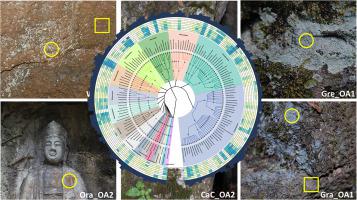Science of the Total Environment ( IF 9.8 ) Pub Date : 2021-09-17 , DOI: 10.1016/j.scitotenv.2021.150395 Jintao He 1 , Nan Zhang 1 , Abrar Muhammad 1 , Xiaoqiang Shen 1 , Chao Sun 2 , Qiang Li 3 , Yulan Hu 4 , Yongqi Shao 5

|
Serious concerns regarding stone biodeterioration have been raised due to the loss of aesthetic value and hidden dangers in stone cultural heritages and buildings. Stone biodeterioration involves a complex ecological interplay among organisms, however, the ecological mechanisms (deterministic or stochastic processes) that determine the microbial community on stone remain poorly understood. Here, using both amplicon and shotgun metagenomic sequencing approaches, we comprehensively investigated the biodiversity, assembly, and function of communities (including prokaryotes, fungi, microfauna, and plants) on various types of deteriorating limestone across different habitats in Feilaifeng. By generalizing classic ecological models to stone habitats, we further uncovered and quantified the mechanisms underlying microbial community assembly processes and microbial interactions within the biodeteriorated limestone. Community profiling revealed stable ecosystem functional potential despite high taxonomic variation across different biodeterioration types, suggesting non-random community assembly. Increased niche differentiation occurred in prokaryotes and fungi but not in microfauna and plant during biodeterioration. Certain microbial groups such as nitrifying archaea and bacteria showed wider niche breadth and likely contributing to the initiation, succession and expansion of stone biodeterioration. Consistently, prokaryotes were more strongly structured by selection-based deterministic processes, while micro-eukaryotes were more influenced by dispersal and drift-based stochastic processes. Importantly, microbial coexistence maintains network robustness within stone microbiotas, highlighting mutual cooperation among functional microorganisms. These results provide new insights into microbial community assembly mechanisms in stone ecosystems and may aid in the sustainable conservation of stone materials of interest.


























 京公网安备 11010802027423号
京公网安备 11010802027423号